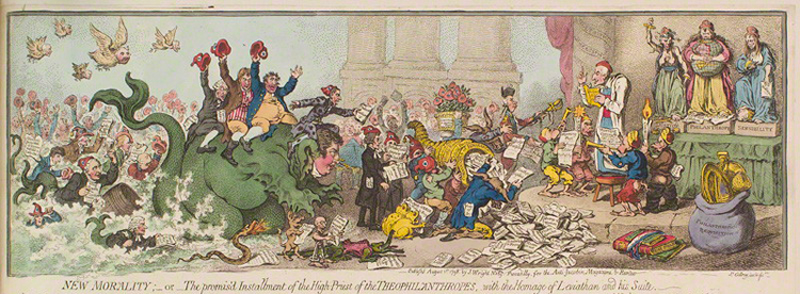New Morality...
Gillray's New Morality, or The Promis'd Installment of the High Priest of the Theophilanthropes, with the Homage of Leviathan and his Suite was created as a large foldout illustration to a verse satire in the style of Pope called "New Morality" by George Canning. The poem and illustration appeared in the conservative Anti-Jacobin Magazine and Review (1798). But the print was also available separately including a caption of lines 314 - 355 from the poem.
The Anti-Jacobin was intended as the conservative response to what was seen as a propaganda war by the French waged through liberal journals such as the Morning Chronicle, Morning Post, and Courier, and left-leaning writers such as Coleridge, Southey, Lamb, Priestley, Wakefield, Godwin, Holcroft, Williams, and others. Gillray had been hired by the ministry in November 1797 to provide print and graphic support to the conservative cause, and The New Morality was one of the results.

© National Portrait Gallery, London
Gillray's print follows the poem selectively, focusing on two sections: one which explains the principles of the new morality and the other which warns of post-apocalyptic world where evil could triumph, where the president of the French Directory, Revelliere-Lepeaux, could be installed at St Paul's Cathedral as the head of the new religion of theophilanthropy, and where Satan/Leviathan could arrive accompanied by an extensive retinue of triumphant, but largely unnamed, British followers waving their revolutionary bonnets rouges.
Not surprisingly, given his penchant for both the specific and apocalyptic, Gillray shows this world as if it has already come to pass. St. Paul's has been seized along with its gold plate. The Bible and Book of Common Prayer have been relegated to providing paper "Pour les Commodites." Lepeaux has been installed as High Priest. Statues of three of the four distorted revolutionary virtues are on display. And Leviathan, now identified as the Duke of Bedford has arrived with Thelwall, Fox, Tierney, and Nicholls all riding on his back. Accompanying them are additional Whig politicians not mentioned in the poem, including Erskine, Norfolk, Burdett, Derby, Courtenay, Landsdowne Taylor, and Lauderdale—all identified by M. Dorothy George.
Given their divided loyalties, it is perhaps appropriate that most of these politicians are portrayed as hybrid creatures—part human and part animal, swimming in or flying above the "yeasty main" provided by a cask of Whitbread's, and similar to the hybrid pigs and asses surrounding Lepeaux and contributing to the Cornucopia of Ignorance spewing what the print calls lies and willful perversions. All of them are animated by a kind of frenetic energy in stark contrast to the solid, stately pillars of St Paul's in the background.
Sources and Reading
- Commentary from the British Museum on New Morality...
- Draper Hill, Mr. Gillray The Caricaturist, 1965, Pl. 73
- "Anti-Jacobin Review," Wikipedia
- "George Canning," Wikipedia
- "Francis Russell, 5th Duke of Bedford," Wikipedia
- "Theophilanthropy," Wikipedia
- "Louis Marie de La Revelliere-Lepeaux," Wikipedia
Comments & Corrections
NOTE: Comments and/or corrections are always appreciated. To make that easier, I have included a form below that you can use. I promise never to share any of the info provided without your express permission.